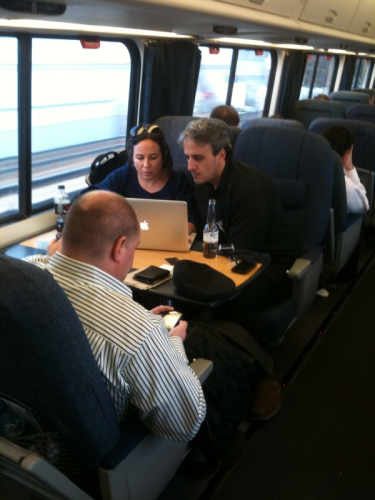Dec 22, 2009
Intercity Bus And Train Traffic Given A Boost By Passengers Bringing Portable Electronic Technology With Them, New DePaul Survey Finds
Intercity Bus And Train Traffic Given A Boost By Passengers Bringing Portable Electronic Technology With Them, New DePaul Survey Finds
For the wired generation, just how critical is it to have total access to digital technology while traveling? A new study by DePaul University’s Chaddick Institute for Metropolitan Development suggests that it may be a major factor when consumers make their long-distance transportation choices.
Intercity bus companies and Amtrak seem to be the principal beneficiaries of the trend thus far. Chaddick researchers surveyed scores of buses, trains and planes in recent weeks to observe the prevalence of technology usage by more than 6,000 passengers traveling through 14 states. At any given point in the trip, nearly 40 percent of passengers on new Wi-Fi equipped buses are using some form of portable technology. The trend was much more pronounced among the new, lower-cost carriers that have been targeting college students and other young adult travelers than on traditional Greyhound buses. Busy Amtrak corridors are not far behind, seeing more than 35 percent of passengers using portable technology at any given point—with even higher use on high-speed Acela trains.
"Our study is the first of its kind," notes Joe Schwieterman, director of the institute and one of the researchers. "We show that portable technology may be encouraging people who would otherwise fly or drive to take a second look at bus and train travel, even when those forms of travel are considerably slower." Low-cost carriers, such as Megabus and Bolt Bus, began offering free wireless access on virtually all their routes in 2008 and their popularity is growing.
Meanwhile, these entrant bus carriers also expanded the number of routes and/or departures this year, leading to 5.1 percent growth for the bus industry as a whole. This is the third consecutive year of traffic growth for the United States intercity bus industry, a sector that had been in a steep state of decline for a half century. Train traffic has been flat, while airline service declined 7 percent in the past year, as measured by the number of departures.
On airlines, the rollout of Wi-Fi this year has been met with lackluster demand—which some believe is due to high fees and the inconvenience of having to shut down computers and other devices for substantial periods of time during the beginning and end of flights. The study found that no more than 18 percent of airline travelers use portable electronic devises at any given point in a trip.
"The prevalence of portable electronics is changing the dynamics of how we make travel choices," says Schwieterman. "For many passengers, the ability to freely use portable technology on a bus or train more than compensates for the longer travel times."
Along the East Coast, free Wi-Fi is now becoming standard for bus operators. In the summer of 2007, DC2NY Bus, another low-cost carrier, launched service between Washington, D.C., and New York offering free Wi-Fi on its entire system—making them the first U.S. carrier to do so. In April 2008, Boltbus, a joint venture of Greyhound and Peter Pan bus lines, launched service out of New York to Boston, Philadelphia and Washington, D.C., with universal free Wi-Fi as well as power outlets. Megabus is adding wireless Web access on its service, first in the Northeast and now in the Midwest. Greyhound is also jumping onboard.
The researchers evaluated the type of technology that passengers use and how use varies at different times of the day. Train travelers are more likely to use technologies that involve LCD screens, such as Blackberries and laptops, than bus travelers, who rely more heavily on audio technologies, such as cell phones and music players, while still regularly checking e-mail.
Editor’s note: To access the full study, go to: http://las.depaul.edu/chaddick/ResearchandPublications/index.asp

Total access to digital technology while traveling may affect which mode of long-distance transportation people choose, a new DePaul study indicates.
